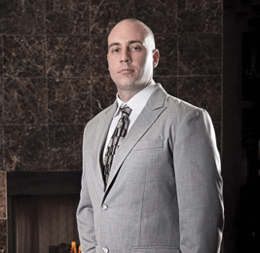
Mount Laurel man led fellow Marines on a series of dangerous encounters in Afghanistan. Now, with a new memoir, he’s making sure their sacrifice is never forgotten.
Deep in the heart of Afghanistan’s lawless southern badlands is a hot, dusty place that U.S. troops refer to as “Hell, man.” The rest of the world knows it as the Helmand Province—home turf of the Taliban, the epicenter of the global narcotics trade funding them, and a gateway for terrorists and drug smugglers streaming back and forth across its porous border with Pakistan. The population is dirt-poor, the government is nonexistent, and the insurgency is everywhere. The landscape is a desolate patchwork of desert wasteland, vast opium-poppy fields, and hardscrabble mudbrick villages blasted by scorching temperatures and blinding sandstorms.
The only thing worse than life in “hell” is death, and that’s what this remote province has become known for in the latter half of America’s longest war—it marked its 12th year in October—in which nearly 2,200 U.S. troops have been killed on its rocky terrain.
These days, the explosive violence that defined the former Taliban stronghold has been somewhat tamed, and the fragile peace has allowed Afghan security forces to take the lead from slowly departing troops. But reaching this milestone was no small feat. In 2009, as a new U.S. president slid into his role as Commander-in-Chief, eight years of simmering conflict had boiled over in Helmand. The insurgency—fueled by Pakistan and backed by regional drug cartels—was winning by sheer killing power. President Obama knew he had to rapidly turn the tide, and he knew there was only one way to get the job done: It was time to send in more Marines, but with the focus on retraining the Afghan army so they could set their sights on withdrawal.
Call of Duty
Meanwhile, back in South Jersey in 2007, a college senior was about to make his unexpected contribution to Operation Enduring Freedom’s high-stakes gamble in southern Afghanistan. Enter longtime Mount Laurel resident and Lenape High School graduate Mark Bodrog. At the time, he was a laid-back, liberal-minded criminal justice major at Rutgers – Camden. Despite a family lineage steeped in decorated military service and a younger brother in the Marines, he was not your typical recruit. He chose to pursue academics, and it wasn’t until he was poised to graduate into an uncertain future that Bodrog heard the siren call of the esprit de Corps.
Within a month of earning his degree, Bodrog was again a freshman, training and taking officer classes in Quantico, Va., while being made into a Marine. It was there he was commissioned a second lieutenant in 2008.
By late-2009, at age 25, he had been ordered to the Third Battalion, Third Marine Regiment in Hawaii and was leading the men of Second Platoon on their first deployment to the deadliest battlefront in all of Afghanistan. And that’s when, as they say, it got real. “I definitely lost sleep over the thought of taking some of this nation’s finest young men to fight at the edge of the empire,” he admits. And it certainly wasn’t lost on the rookie platoon commander that part of the job was to bring them all back home.
‘The Edge of the Empire’
Spring in southern Afghanistan is no picnic. As the weather warms up, so does the “fighting season,” when Taliban insurgents emerge from a winter of rest and rearmament in Pakistan to re-assert control over local villages and their poppy crops. But 2010 would be different. With wave after wave of coalition forces fanning out through the province, a change in fortune greeted returning enemy combatants.
That June, as temperatures climbed past 120 degrees, Bodrog’s infantry platoon was in Helmand’s volatile Nawa District, fortifying a rustic patrol base tucked alongside the so-called “Desert of Death.”
To say their new home lacked creature comforts would be generous. There were no showers, no bathrooms, no cold water, no beds, and what some might consider worst of all, no Wi-Fi. “It was rough,” he says, “but these types of conditions are actually preferable in a war zone; if you get too comfortable, you get complacent.”
There was little threat of that, though. Despite the boiling desert heat, staying alive meant strapping on at least 60 pounds of gear. In addition to manning vehicle checkpoints, a typical sweaty, dust-caked day included harrowing foot patrols over gravel hills, mucky canals, and through the mud-wall mazes of nearby village compounds—all perfect hiding spots for improvised explosive devices (IEDs), which the platoon found with unsettling regularity.
The most critical component of Second Platoon’s mission, however, was to “win the hearts and minds” of locals—a cornerstone of the counterinsurgency (“COIN”) doctrine now guiding the war effort. In effect, it was less about engaging enemy combatants in a firefight and more about engaging village elders over tea—which led to the base’s first attack, though it was not from insurgents.
“Within a week, half the platoon had some sort of gastrointestinal virus. We each lost about 25 pounds. … Marines running past each other to relieve themselves at all hours of the night was not a pretty sight,” Bodrog recalls, grimacing. “Our training encouraged us to eat and drink with the locals, but you really had to be careful—everything was infested with bacteria. It took a minute or two to understand that a cup of tea is made from the same canal water the people bathe and go to the bathroom in.”
On the positive end of the health spectrum, however, Marine medics quickly became a key point of COIN-based interaction, treating a steady stream of local patients. The injuries suffered by children were toughest on the troops, Bodrog says. One common practice of villagers was to throw boiling water on crying or misbehaving infants, causing severe burns. Another waking nightmare was the frequency with which young girls and boys alike were violently raped.
But the war bred its own horrors. A particularly hellish mid-September combat operation unfolded in one of the military’s “gray areas,” where a lack of tactical importance limited the Marine presence, which, in turn, made it a hotbed of insurgent activity. “The type of combatants we fought in a place like that would run at you with an AK-47 in one hand and a baby in the other, because their only strategic advantage was that we couldn’t shoot babies,” Bodrog remarks, shaking his head. “These were the dilemmas my young 18- and 19-year-olds had to face in dealing with an uncivilized, irrational enemy who placed no value on life. He would go to extremes to beat us, because he had no limits and we did.”
Struggling to describe some of the horrors he and his men saw, Bodrog chooses to suffice it by saying, “There are some things you can’t prepare for. You just have to handle them as they come.”
And handle them they did. In fact, Bodrog became so impressed with his young Marines’ hard work and the resulting accomplishments that he began to document their experience. “My guys had removed dozens of IEDs, confiscated over 250 pounds of drugs, arrested a ton of Taliban, saved lives; they were doing such great things, but I’d call back home and learn that only bad news was getting reported. I started writing everything down so their heroic efforts weren’t some lost chapter in our nation’s history,” he says, “and before I knew it, I had 40 pages.” Eventually he’d have nearly 40 notebooks, all detailing the daily victories and narrow escapes that are just part of the job when you’re part of the Corps. Bodrog would later turn his handwritten observations into a memoir, Second Platoon: Call Sign Hades, A Memoir of the Marines of the Combined Action Company, which was released late last year as a tribute to the everyday heroes he commanded on the outskirts of hell.
As per the title, it also serves as an innovative blueprint for “combined action”—a COIN technique dating back to the Vietnam War, when Marines embedded with locals to fight against a common enemy.
Bodrog’s battalion took it to the next level, partnering his platoon and one other with a unit of Afghan National Army (ANA) soldiers in a one-to-one ratio. Though designed to take some of the combat burden off of Marines, the unique arrangement was not without its challenges. “The Afghan military was very new at the time, and the majority of its members had no training or discipline. That made it very frustrating at first. Half of them were on drugs, and a lot of them were really just there for the paycheck,” Bodrog muses. “You ever see The Bad News Bears? It was sort of like that.”
Nevertheless, the two-man teams did everything together—eating, sleeping, shaving, showering, studying, going on missions—you name it, they did it in unison. The hardest part was getting a rookie band of ragtag soldiers up to Marine standards—and their Full Metal Jacket approach was not flying with the Afghans, Bodrog quickly came to realize. “They simply did not embody our warrior ethos. If we pushed too hard, they’d throw down their rifles and quit.”
But within a month of softer soldiering, the Afghans showed remarkable improvement, joining patrols and later taking the lead in combat operations. It wasn’t long before Marines began to appreciate the worth of their comrades, who were familiar with both the tricky terrain and the tricks of the enemy.
More useful still was their ability to act outside of the strict rules of engagement imposed upon coalition forces. As the summer progressed, the dual platoons’ joint operations improved security in the region, and the goal of leaving the ANA in charge came closer to fruition, which greatly improved morale, Bodrog says. But the real clincher was Rambo—Rambo III, to be exact. One mid-summer movie night, the Marines invited the Afghans to join them for Sly Stallone’s epic takedown of the Russian military, alongside Afghanistan’s mujahedeen fighters. It brought the house down, he says, laughing. “Seeing them all together, jumping out of their seats, cheering for the same hero—at that moment I was really proud of how far we’d come, and I think it showed that in uniting against our common enemy, we were doing the right thing.”
Mission Accomplished
Bodrog’s battalion lost three Marines during the seven-month deployment, including his friend and fellow company commander 1st Lt. Scott Fleming. The deaths hit hard, yet he never let his men see him down. “I had to reflect on their sacrifice privately. As a leader, you can’t let your emotions show,” he says. “I also realized that any day the same thing could happen to any one of us.”
More so, he was aware that part of honoring fallen brothers was winning the war. And by the time elections were held in the fall of 2010, it was clear the tides had turned in that direction. Despite the devastating loss of Fleming—shot during September’s pre-election security operations—Nawa was the only provincial location with no reported Taliban attacks the day Afghans hit the polls. By the time Bodrog and his band of devil dogs departed the region that December, the difference they’d made in the former stomping ground of the insurgency was clear: It had come to be regarded as a model of COIN operations, and Nawa was considered the most stable district in Helmand—the very “poster child for how things have gone well in Afghanistan,” according to Gen. James Amos, head of the Marine Corps.
A year later, Bodrog was redeployed to the province, this time in the Garmsir District—and this time, his South Jersey ethos took hold. “By then I understood the culture of greed we were feeding,” he says, in reference to the millions being spent on village-based reconstruction initiatives. “Sure, I was proud of my men for building bridges and canals, but the Taliban was so immersed in local communities that it was clear they were extorting project dollars. In my view, we were funding the enemy.” Bodrog went against protocol, taking a hard line against the military’s blind payouts to Taliban-friendly villages by demanding local intel for U.S. dollars. “I wanted to know where the bad guys were, where they hid the IEDs—if people came forward with that information, I was fine with them keeping the money. But in my mind, there had to be a return on investment. I felt a responsibility—at the very least to the taxpayers of New Jersey,” he says, half-jokingly. “In the end, I thought the right thing to do was use our money as a weapon.”
Though Bodrog ruffled a few feathers, his second tour was touted much like his first, and his work in Afghanistan was done by the summer of 2012. Between 2009 and 2012, he had served in several capacities, including platoon commander, assistant operations officer and executive officer. He wrapped up as a first lieutenant and company commander, and stayed on in the reserves. That’s when he began a new mission: transcribing hundreds of weather-battered notebook pages into an account of a remarkable Marine unit serving their country in the least remarked-upon war to date. By 2013, his manuscript was in the hands of publishing company iUniverse and he was back on campus at Rutgers – Camden pursuing a graduate’s degree in criminal justice. He also moved to Camden and started a nonprofit veterans advocacy organization—Always Faithful, LLC—designed to help in the transition back to civilian life.
It’s said that war is a relative experience; some love it, some are broken by it. Bodrog, now 29, seems to fall somewhere in the middle. He saw combat, and he saw the power of peace. He saw death, and he saw people escape it. He saw places that made the worst neighborhoods in Camden look like a day in the park, and he saw some of those places given a new lease on life with a little help from the outside world. But, what he saw in the young Marines of Second Platoon had more of an impact than everything else combined, and so he hopes people see his memoir as the tribute it’s meant to be. “They were truly the embodiment of the American Dream, making the world a better place,” Bodrog says.
“And I find meaning in the fact that I’ve helped them make their mark in history.”
Published (and copyrighted) in South Jersey Magazine, Volume 10, Issue 12 March, 2014).
For more info on South Jersey Magazine, click here.
To subscribe to South Jersey Magazine, click here.
To advertise in South Jersey Magazine, click here.











